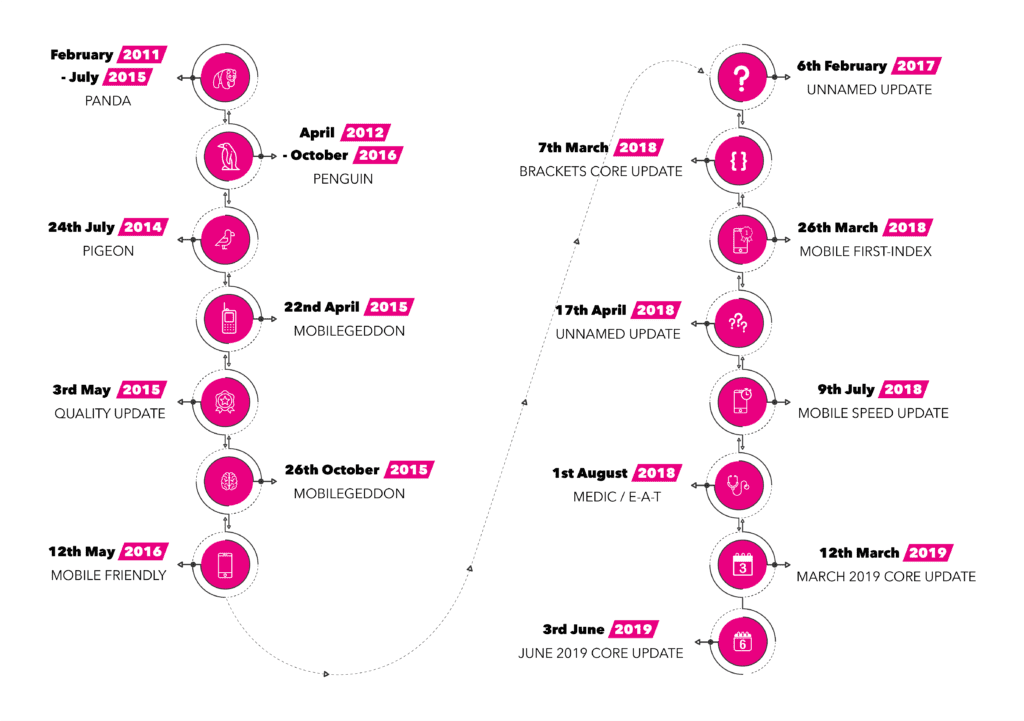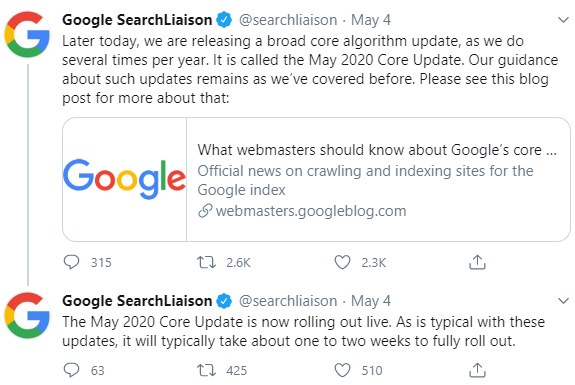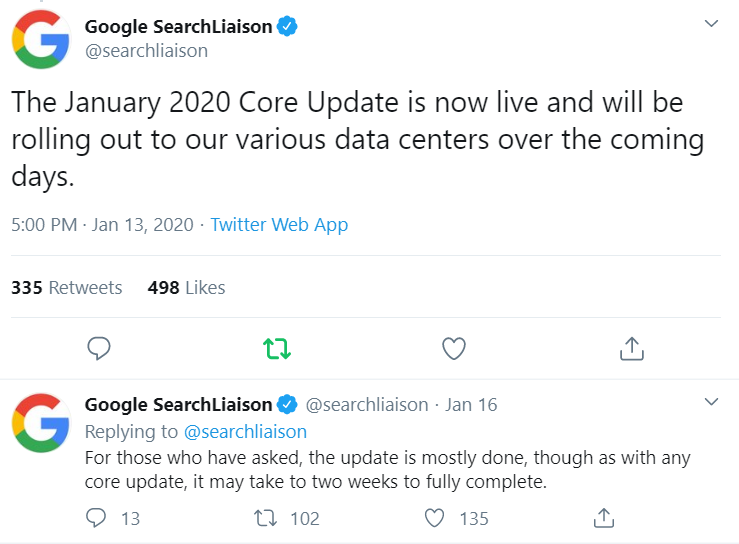What is a Google Algorithm Update?
A Google algorithm update essentially means alterations have been made by Google in terms of how they assess the rankings of websites, based on a multitude of factors.
Google is ever-tweaking and updating their algorithm, therefore positions of webpages change in the search engine results page (SERP). So, for you, your website’s rankings may change. If so, organic traffic to your site could be affected either positively or negatively as a result.
Google is constantly making small changes but a few times a year they roll out a major algorithm update. What were the major ones in the past few years? And which came first? In this post, we present a short history of confirmed Google algorithm updates from Panda through to the recent June core update in 2019.

List of Google Algorithm Updates
- May 2020 Core Update
- January 2020 Core Update
- BERT Update
- September 2019 Core Update
- June 2019 Core Update
- March 2019 Core Update
- Medic/E-A-T Update
- Mobile Speed Update
- Mobile First-Index
- Brackets Core Update
- Mobile Friendly 2
- RankBrain
- Quality Update
- Mobilegeddon
- Pigeon Update
- Penguin Update
- Panda Update
What is the May 2020 Core Update?
The May 2020 Core Update was the latest of Google’s broad core algorithm updates, the second one of the year, and the first core update to have been rolled out since the COVID-19 pandemic. Just like the January core update, this one was announced in advance via the Google Search Liaison account on Twitter, but once again not far in advance as it begun rolling out no less than 90 minutes later.
When did the May 2020 Core Update happen?
This core update began on 4th May 2020, with guidance from Google that it could take a period of one to two weeks to fully roll out, as is typical. Moz reported that the most impact from this update was particularly felt between 4th May and 6th May 2020.

What did the May 2020 Core Update affect?
With reportedly the second highest rankings flux from a core update since Medic in August 2018, early reaction to the May 2020 Core Update saw publishers and webmasters in spaces such as news, health and medical, and finance observe significant ranking shifts and, often, complaints of negative movements that led to traffic declines. A notable example was Search Engine Roundtable, who themselves provide news coverage of Google’s algorithm updates and the aftermath of them, who would see a 30% decline in traffic from Google.
A connection may have been made between the May 2020 update and Google deindexing pages of a website. In this same month, John Mueller at Google spoke of deindexing on a hangout, essentially stating Google may no longer want to index particular parts of a site that don’t meet their benchmark of quality, so not to expect all content to be indexed, even if requested by a webmaster. How that relates to this algorithm is sites that were hit in some cases also found themselves with less indexed pages. Going back to Search Engine Roundtable, their drop in traffic was accompanied by a 35% drop in indexed pages.
An informative piece by onely.com on Google’s approach to rendering certainly suggests updates like this one are having an influence on indexing trends. This analysis reports an increase in JavaScript indexing this month, with HTML indexing declining as a result, and suggests the increasing expense for search engines like Google to parse and render webpages is reason they will have to determine, from a quality point of view, the most worthy content to index.
What is the January 2020 Core Update?
The January 2020 Core Update was another in a series of pre-announced algorithm updates and the first of the new year. The announcement came, as per usual, via Twitter and approximately one hour later, Google went on to state that the update was live and rolling out.

When did the January 2020 Core Update happen?
This core update began on 13th January 2020 and was reported to be largely complete within only a few days but with subsequent fluctuations expected over a period of two weeks.
What did the January 2020 Core Update affect?
Data collated from various sources including RankRanger, SearchMetrics and Sistrix illustrated that this update was a significant one with an impact to a large number of sites, with a clear indication that YMYL (Your Money or Your Life) sites – specifically those in health and finance niches – experienced the most volatility.
Sistrix analysis suggested that these YMYL sites and their topics had, with this core update, been re-evaluated by Google, with domains previously affected by past algorithm updates the more likely to be impacted again. The January 2020 update was also likened to prior updates by Google in September and March of 2019 in its characteristics of scrutinising the health/medical space with a focus on trustworthiness.
What is the BERT Update?
BERT was announced by Google as an algorithm update on the week it was rolling out, who described it as a “significant improvement to how we understand queries, representing the biggest leap forward in the past five years, and one of the biggest leaps forward in the history of Search.” In 2018, Google introduced a natural language processing technique called Bidirectional Encoder Representations from Transformers (that’s where ‘BERT’ comes from) and fast forward to 2019 this algorithm update marked those BERT models being applied to search.
When did the BERT Update happen?
This Google update officially came into effect on 25th October 2019.
What did the BERT Update affect?
As confirmed by Google, on launch BERT would impact 1 in 10 of all search queries in the U.S. in English (with plans to introduce the same to more locales over time) and would, at the time, be the most significant change in search since Google released RankBrain.
BERT models were applied to both ranking results and featured snippets with the intention to help searchers find more useful information. With the update, for a given search query Google stated their algorithm would now process words of that query in relation to all of the other words in the sentence, rather than the traditional order of one-by-one. Essentially, this was Google deeming context as key to understanding the intent behind search queries.

On the announcement blog post, Google offered some examples of queries where BERT was now helping them pick up on nuances of human language. The query shown in the screenshot above was one such example: “Can you get medicine for someone pharmacy” – here, Google demonstrate that “for someone” is an important part of the search the user made and this element of the query is now understood by BERT when previously it was missed (see Before in the screenshot).
What is the September 2019 Core Update?
This Google update was another in a series of algorithm tweaks that Google would give a specific name to (rather than staying coy and leaving the name up to the SEO community). This update was also announced in advance by Google but only on the same day it was rolled out.
The announcement came via Twitter, as did a further update to say the September 2019 Core Update had gone live:

When did the September 2019 Core Update happen?
This core update began on 24th September 2019 and speculation was it ran through Google’s birthday on the 27th.
What did the September 2019 Core Update affect?
Based off early indications in the first 24 hours, the update was slow to roll out but after a few days more of an impact was beginning to be felt. For one, the Daily Mail, who had been enormously impacted by the June 2019 Core Update, were amongst the big winners in the UK. Conversely, some news-related websites were negatively impacted by this update. Overall, it appears that the most volatility following this update was with sites in the health/medical space. Like the updates that preceded this one, clearly E-A-T – expertise, authority and trustworthiness – played a part once again.
What is the June 2019 Core Update?
The June update was significant in that Google gave it a name again (see: March update) and in a rather unprecedented move announced the update in advance on Twitter. Not only did they confirm exactly when it began, but Google also told us when it had finished rolling out.

When did the June 2019 Core Update happen?
This update had a 5-day roll out between 3rd June and 8th June 2019.
What did the June 2019 Core Update affect?
Early analysis reported that the field of domains affected by this algorithm update was wide-ranging and included news sites, retail sites and others classed as YMYL (Your Money or Your Life) – those involving financial transactions or health/lifestyle.
A significant impact was felt by certain websites such as the UK news site Daily Mail which publicly revealed they had lost 50% of their daily traffic. The principles of E-A-T – expertise, authority and trustworthiness – seemed to be at play again here (see: Medic update), now with close emphasis to the Trust element.
What is the March 2019 Core Update?
Google announced this core update via Twitter which was significant because that was still quite a rare occurrence. This was tweeted during the week the update was rolled out, but not in advance. Google also gave this update a name – the March 2019 Core Update. Perhaps this was a move to control the names the SEO community were giving to these updates.

When did the March 2019 Core Update happen?
12th March 2019.
What did the March 2019 Core Update affect?
Specifics were not divulged as to what this update entailed, however the effects felt were major for websites in the medical or health space. The March update was speculated to be a possible reversal of or tweaking to the previous Medic update from August 2018.
The analysis of the update showed Google continued to fine-tune search results for sensitive topics such as health-related ones; in this industry, it was observed that some of the biggest winners from the previous update were now amongst the biggest losers following the latest one. A follow on from the Medic update, it was clear that this update further cemented the need for E-A-T (Expertise, Authority & Trust) and strong branding in the eyes of Google.




